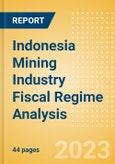The 'Indonesia Mining Industry Fiscal Regime Analysis - Governing Bodies, Regulations, Licensing Fees, Taxes, Royalties, 2023 Update' provides a comprehensive analysis of the mining sector in Indonesia, focusing on key aspects such as governing bodies, laws and regulations, governance frameworks, and sustainability practices. The report also includes mining related taxes and royalties.
Indonesia has abundant minerals, including coal, gold, bauxite, copper and nickel, alongside potential to produce alluvial diamonds. It plays a crucial role in the global coal markets and is among the largest suppliers of coal to Asian markets such as India, China, South Korea, Japan, and Taiwan. The country's mining industry is a key contributor to the nation's economic growth. The country's mining contribution to GDP stood at 11.9% during the first quarter of 2022.
Indonesia is the leading producer of nickel in the world and also produces gold, copper, bauxite, among other minerals. According to the US Geological Survey (USGS), as of January 2023, Indonesia has 21.0% of the world's nickel reserves, 5.0% of its gold, and 3.2% of bauxite reserves.
The Ministry of Energy and Mineral Resources (MEMR) is the country's chief governing body. It endeavors to improve energy and mineral operations, making more efficient, sustainable, and environmentally friendly. The Association of Exploration and Mining Development Indonesia promotes the minerals sector in Indonesia in socially, politically, environmentally, and commercially responsible ways. In addition, it also attracts investment for new resource discoveries in the country and assists the government in developing mineral policies.
Indonesia has abundant minerals, including coal, gold, bauxite, copper and nickel, alongside potential to produce alluvial diamonds. It plays a crucial role in the global coal markets and is among the largest suppliers of coal to Asian markets such as India, China, South Korea, Japan, and Taiwan. The country's mining industry is a key contributor to the nation's economic growth. The country's mining contribution to GDP stood at 11.9% during the first quarter of 2022.
Indonesia is the leading producer of nickel in the world and also produces gold, copper, bauxite, among other minerals. According to the US Geological Survey (USGS), as of January 2023, Indonesia has 21.0% of the world's nickel reserves, 5.0% of its gold, and 3.2% of bauxite reserves.
The Ministry of Energy and Mineral Resources (MEMR) is the country's chief governing body. It endeavors to improve energy and mineral operations, making more efficient, sustainable, and environmentally friendly. The Association of Exploration and Mining Development Indonesia promotes the minerals sector in Indonesia in socially, politically, environmentally, and commercially responsible ways. In addition, it also attracts investment for new resource discoveries in the country and assists the government in developing mineral policies.
Scope
The report focuses on the mining fiscals' key aspects such as governing bodies, laws and regulations, governance frameworks, and sustainability practices. The report also includes mining related taxes and royalties.Reasons to Buy
- To help businesses navigate the complexities and comply with the necessary requirements
- Obtain up-to-date information on mining sector taxes and payments
- Enhance your decision-making capability in a more rapid and time sensitive manner
- Conduct analysis to mitigate the impact of regulatory changes
- Understand the regulatory framework
- Gain an overview of the mining industry structure by identifying country's mining governing bodies, major laws and licenses
Table of Contents
- Executive Summary
- Country Overview
- Mineral Overview
- Governing Bodies
- Law and Regulations
- Rights and Obligations
- Mineral Licenses and Mining Areas
- Taxes and Royalties
- Sustainable Mining Practices
- Appendix
- Abbreviation








